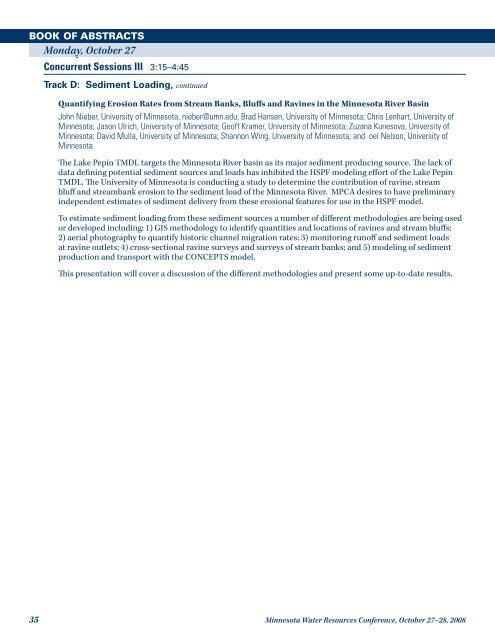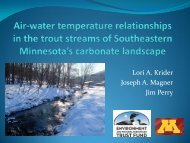Minnesota Water Resources Conference - Water Resources Center ...
Minnesota Water Resources Conference - Water Resources Center ...
Minnesota Water Resources Conference - Water Resources Center ...
You also want an ePaper? Increase the reach of your titles
YUMPU automatically turns print PDFs into web optimized ePapers that Google loves.
BOOK OF ABSTRACTS<br />
Tuesday, Monday, October 27 23<br />
Concurrent Sessions III 3:15–4:45<br />
Track D: Sediment Loading, continued<br />
Quantifying Erosion Rates from Stream Banks, Bluffs and Ravines in the <strong>Minnesota</strong> River Basin<br />
John Nieber, University of <strong>Minnesota</strong>, nieber@umn.edu; Brad Hansen, University of <strong>Minnesota</strong>; Chris Lenhart, University of<br />
<strong>Minnesota</strong>; Jason Ulrich, University of <strong>Minnesota</strong>; Geoff Kramer, University of <strong>Minnesota</strong>; Zuzana Kunesova, University of<br />
<strong>Minnesota</strong>; David Mulla, University of <strong>Minnesota</strong>; Shannon Wing, University of <strong>Minnesota</strong>; and oel Nelson, University of<br />
<strong>Minnesota</strong><br />
The Lake Pepin TMDL targets the <strong>Minnesota</strong> River basin as its major sediment producing source. The lack of<br />
data defining potential sediment sources and loads has inhibited the HSPF modeling effort of the Lake Pepin<br />
TMDL. The University of <strong>Minnesota</strong> is conducting a study to determine the contribution of ravine, stream<br />
bluff and streambank erosion to the sediment load of the <strong>Minnesota</strong> River. MPCA desires to have preliminary<br />
independent estimates of sediment delivery from these erosional features for use in the HSPF model.<br />
To estimate sediment loading from these sediment sources a number of different methodologies are being used<br />
or developed including: 1) GIS methodology to identify quantities and locations of ravines and stream bluffs;<br />
2) aerial photography to quantify historic channel migration rates; 3) monitoring runoff and sediment loads<br />
at ravine outlets; 4) cross-sectional ravine surveys and surveys of stream banks; and 5) modeling of sediment<br />
production and transport with the CONCEPTS model.<br />
This presentation will cover a discussion of the different methodologies and present some up-to-date results.<br />
35 <strong>Minnesota</strong> <strong>Water</strong> <strong>Resources</strong> <strong>Conference</strong>, October 27–28, 2008
















